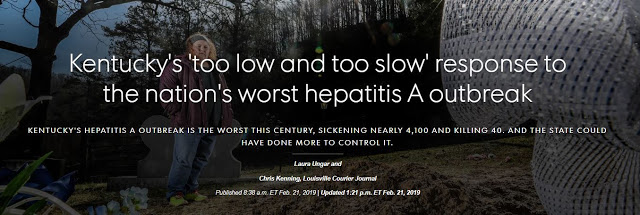Ky. officials rejected infectious-disease chief’s plea to move faster against hepatitis A outbreak, now nation’s largest and deadliest

As part of a package of stories about Kentucky’s hepatitis A outbreak, which is the “worst this century, sickening nearly 4,100 and killing 40,” Laura Ungar and Chris Kenning of the Courier Journal write that the “state could have done more to control it.”
“Brawley argued that a powerful state response was needed: $10 million, including $6 million for a fusillade of 150,000 vaccines and $4 million for temporary health workers to help administer them. In an email, he also lobbied for a public health emergency declaration to bolster the case for more federal money,” Ungar and Kenning report. “His urgent pleas went nowhere. And in the months that followed, Kentucky’s outbreak metastasized into the nation’s largest and deadliest.”
The Courier Journal found that Brawley’s “aggressive recommendations” were rejected by his boss, 31-year-old acting Health Commissioner Dr. Jeffrey Howard. Now Kentucky’s death toll from this outbreak is the highest in the nation.
“Amid limited state budgets, county staffing constraints and the availability of more than $220 million in local health-department reserve funds — he stuck instead to a $3 million state response,” the CJ reports. “The state ultimately sent $2.2 million to local departments and declined to declare an emergency. In addition, county health departments added little to no staff to increase efforts to find and vaccinate drug users and homeless people.”
Ungar and Kenning report that Kentucky “never tried strategies used successfully by some of the other 15 states who fought outbreaks with limited budgets,” like seeking money from the state legislature, deploying “strike teams” of state health workers to counties, and immediately deploying state funds for the epidemic.
The article details the decision-making process of Howard, who stood by his decisions, though he did acknowledge that in retrospect he could have done some things differently.
“I wish I would’ve been more bold and said, ‘Let’s move into Eastern Kentucky,’ as opposed to waiting, as we did,” said Howard, who grew up in Appalachia. “As an Eastern Kentucky guy, it’s heartbreaking to see this disease spread out in rural Kentucky. And I knew the struggles that they’d have once it started.”
Adam Meier, secretary of the Cabinet for Health and Family Services, told the reporters that he stood by Howard’s choices, saying in a statement that the “challenges Kentucky faced were less financial and more logistical in nature as it related to identifying and engaging the at-risk populations. While hindsight might provide more context for some things now, in retrospect there’s not a single decision that I’m aware of that was made in real time, with the information available at the time, that I would change.”
But Brawley, who resigned in June, told the Courier Journal that much greater resources were needed to battle Kentucky’s spread of hepatitis A and called the state’s response “too low and too slow” for what has become “the worst hepatitis A outbreak in the United States in the 21st century.”
He added, “Had the state hastened its vaccination efforts, it may have more quickly reduced the risk of the disease’s spread and prevented acute cases, hospitalizations for about 50 percent of those cases, deaths and avoided millions of dollars in healthcare expenses for emergency department visits and hospitalizations.”
Ungar and Kenning reported that several others in the health department agreed with Brawley’s recommendations, including nurse Margaret Jones, manager of the state’s immunization program. “We should have done more sooner,” said Jones, who retired last summer. “If we had been able to get the vaccines out early, we may not have near as many cases or near as many hospitalizations. … He knew what to do. I think his advice should have been heeded.”
Now, state health officials are hopeful the hepatitis A outbreak has crested. The number of new cases each week is down from 150 in early November 2018, averaging 87 a week this year. Officials said their plans in 2019 include “working to help local departments vaccinate more regularly at jails, increase vaccinations generally, enlist more federally qualified health centers to administer vaccines, and continue to push out federally funded vaccine to counties,” the CJ reports.
The newspaper published four other articles on this topic on the same day.
Ungar tells the story of an Eastern Kentucky woman who learned she had hepatitis A, along with her existing hepatitis C, while getting treatment for her heroin and methamphetamine addiction. Another story covers how other states have responded to the outbreaks of the disease, reporting that since 2017, 16 states have had outbreaks, infecting more than 13,000 people. Another details how hepatitis A spread across Kentucky.
the final story, written by Kenning, chronicles the story of an Appalachian woman with a heroin addiction who said she didn’t know about the highly contagious virus, and even if she had, she wouldn’t have cared. “People who are addicted like myself, I really didn’t care if I lived or died. So I (wouldn’t have) really cared if I was infected with it,” she said.